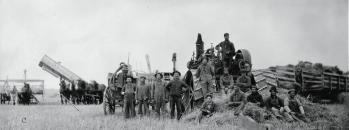
The first grain was shipped from Manitoba to an international market in 1878; this was the beginning of an agricultural economy on the Canadian prairies. The National Policy of the Macdonald government opened the prairies to rapid settlement with the construction of the Canadian Pacific Railway. Agricultural development required a large workforce and a massive amount of capital. The Canadian government worked with immigration agents and transportation companies to attract North American and European migrants to become agricultural settlers on land recently acquired from the Hudson's Bay Company, and surveyed for settlement after signing treaties with Aboriginal tribes. Many of the settlers arrived from eastern Canada and the United States; they were attracted by the opportunity to improve their status and independence. British and northern Europeans arrived along with eastern Europeans who came for free land.
Saskatchewan had the largest agricultural land base, and the population grew from 90,000 in 1900 to 930,000 by 1930. The majority lived or worked on farms. The most successful farmers started with some capital for farm equipment and animals, building materials, and supplies. Many migrants, having come without money, worked for more established farmers and gained experience until they could afford their own farms. The agricultural workforce included farmers, their sons, and paid workers; farm women and their daughters also provided labour. Farm work was seasonal, with peaks during spring seeding and especially during harvest. There were ongoing chores to look after farm animals; horses were used for work and required care and skills to manage. Summer jobs included summerfallowing, hay production, and breaking new land. Workdays were long, and the workers, isolated on dispersed farms, had to operate a variety of machines. Wages varied by season, by job, and by region. Living conditions and food were often poor, as farmers reneged on paying wages. Politicians, sensitive to the large farm vote, initiated many programs to assist the farmers. Working with railways and steamship lines, the government organized harvest excursions to transport unemployed workers from the Maritime provinces, the United States, and Britain to the prairie farms. During World War I military men were granted 30 days' furlough to work on prairie farms. Farm workers were exempt from most labour legislation and fell under the Masters and Servants Act.
By 1920, all the homesteads were taken and the farm economy was depressed by renewed agricultural production in Europe. Most farmers' sons and paid workers no longer had the possibility of starting their own farm. Without this option as potentially independent farmers, their status dropped; many drifted into cities, where unemployment was also high and workers were being influenced by union organizers and radical politics. In the early 1920s the Industrial Workers of the World tried to organize Canadian farm workers. The federal government harassed and arrested potential organizers, and turned back harvest workers from the United States who were suspected of being “Wobblies.”
During the Depression of the 1930s the federal government started work camps for unemployed urban workers. It also worked with provincial governments, particularly in Saskatchewan, to organize farm employment plans to match unemployed farm workers with farmers requiring help, but with no money to pay workers. After 1935, the new Liberal government expanded this program but tried to restrict it to urban workers when they closed the labour camps. After World War II, increased mechanization on the farms reduced the need for labour and workers were able to move on to higher-paying jobs in cities, and to work in mines and lumber camps. With increasing numbers of corporate farms, especially in livestock operations, the need for farm workers is increasing. They have been exempted from most labour legislation, but have unionized a few hog barns and have had extended strikes in operations near Biggar and Purdue.
Bob Ivanochko